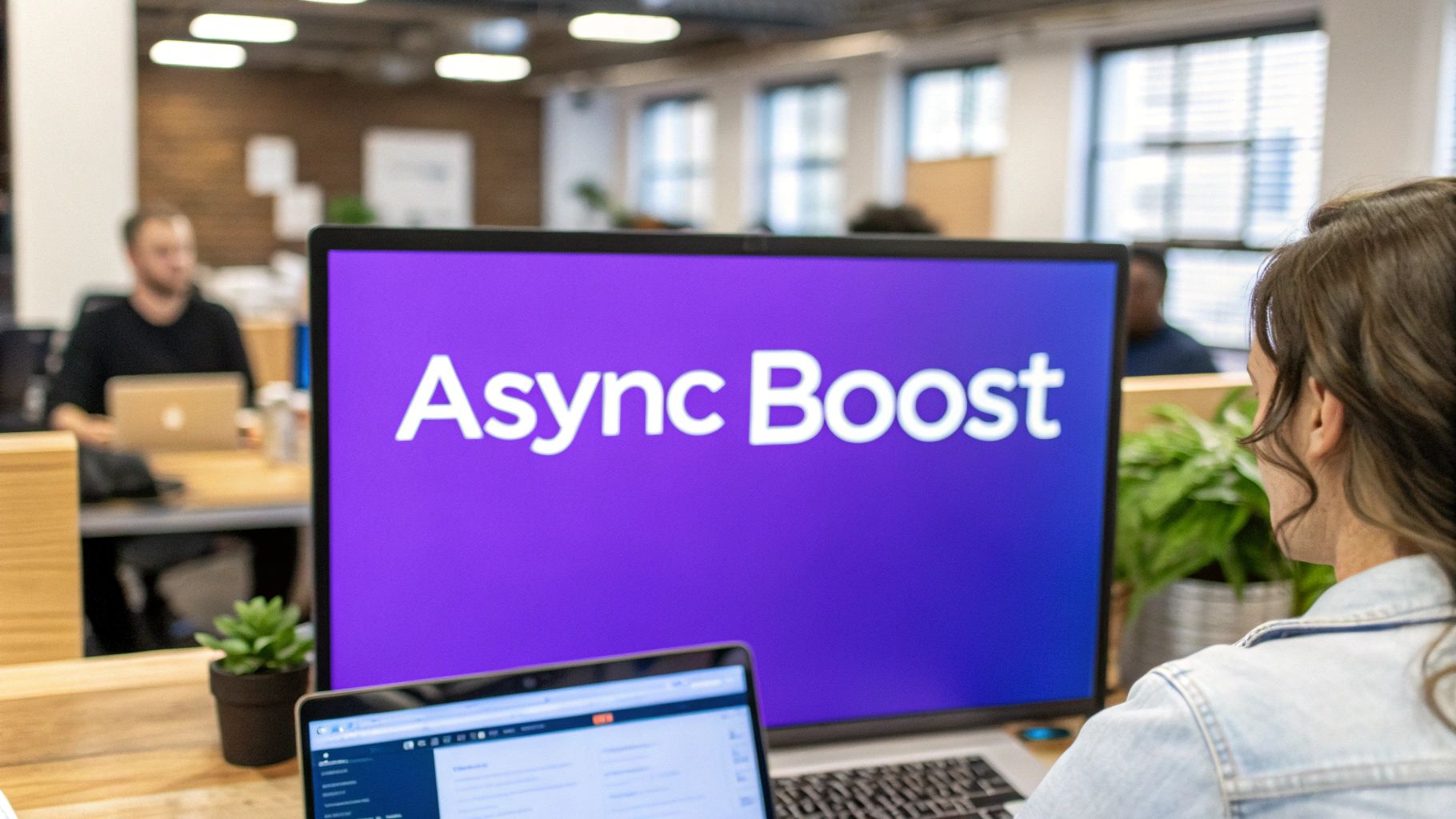Mastering the Art of Asynchronous Collaboration

What is asynchronous collaboration? Simply put, it’s teamwork without the need for everyone to be online at the same time. Team members contribute to projects at their own pace and on their own schedules, regardless of time zones. This is a significant departure from traditional synchronous work, which requires everyone to be present simultaneously. Asynchronous collaboration leans heavily on tools like project management software, shared documents, and email for communication and coordination.
Key Principles of Effective Asynchronous Collaboration
Successful asynchronous collaboration depends on a few key principles. First and foremost is a documentation-first mindset. This means meticulously recording all important information, decisions, and progress updates in a central, accessible location. This eliminates repetitive conversations and keeps everyone informed.
Another crucial principle is embracing self-directed workflows. Team members manage their own tasks and deadlines, contributing when they are most productive. This encourages autonomy and minimizes distractions, allowing for deep, focused work.
This approach stands in stark contrast to the traditional meeting-heavy culture often associated with synchronous teams. Instead of constant real-time interaction, asynchronous collaboration values focused individual work and clear, documented communication.
This shift also acknowledges different working styles and schedules, leading to a healthier work-life balance by respecting personal boundaries and reducing the pressure of constant availability. The rise of remote work has made effective asynchronous collaboration even more critical.
By 2025, a projected 32.6 million Americans will work on remote teams, demonstrating the increasing importance of asynchronous methods for successful collaboration across different time zones and locations. This change is driven by a desire to reduce meeting fatigue and increase productivity, as studies show workers spend 58% of their time on ‘work about work’ and endure 129 hours annually in unproductive meetings. Explore this topic further.
Why Async Works
Asynchronous collaboration is more than just using different tools; it represents a fundamental shift in how teams operate. This approach leads to better documentation, creating a valuable knowledge base for current and future team members. Decisions and their reasoning are transparent and readily accessible, which increases understanding and accountability.
Ultimately, this method empowers teams to work faster and more efficiently, leading to better project outcomes and greater job satisfaction. By embracing asynchronous collaboration, teams can unlock their potential for increased productivity, improved communication, and a more balanced work experience.
Why Teams Are Embracing Async Work (And Thriving)

Beyond flexible schedules, asynchronous collaboration is changing how teams work. It’s not just about adopting new tools; it’s a shift in the entire work philosophy. Asynchronous work helps teams move past the limitations of real-time meetings and allows for deep, focused work. This means individuals can contribute when they’re most productive, resulting in higher quality work and greater job satisfaction. Let’s explore why teams are not only adopting async, but thriving in this new environment.
Increased Productivity and Deep Work
One of the biggest benefits of asynchronous collaboration is fewer interruptions. Constant meetings and instant messages disrupt focus and make deep work difficult. By switching to async, teams create space for uninterrupted concentration, allowing individuals to fully focus on complex tasks. This leads to better results and quicker completion times.
Think of a software developer working on a key feature. In a synchronous environment, constant interruptions can break their concentration, leading to mistakes and delays. But with asynchronous collaboration, they can work undisturbed, producing better code more efficiently. Async work also allows for more thoughtful and considered responses. Instead of quick replies in meetings or instant messages, team members can reflect and formulate well-structured contributions. This leads to better communication and decision-making.
A key advantage of asynchronous collaboration is its positive effect on efficiency and task completion time. A study in a healthcare setting showed that using asynchronous communication platforms led to a mean reduction of 58.8% in task completion time compared to traditional synchronous methods. This translated to an average reduction of 20.1 minutes per task. This improvement in efficiency is because asynchronous platforms deliver messages quickly without requiring immediate responses, allowing healthcare professionals to manage their workflow better. This way of working also allows team members to focus on tasks without interruptions, which means more thoughtful responses. Find more detailed statistics here.
Global Inclusivity and Enhanced Communication
Asynchronous collaboration creates inclusive environments for global teams. Team members in different time zones can contribute equally, no matter their location or schedule. This eliminates the limitations of traditional synchronous meetings, which often exclude people in different time zones.
For example, a marketing team spread across multiple continents can effectively collaborate on a campaign using async methods. Team members in Asia can provide input overnight, which the European team can then review and build on the next morning. The North American team can then contribute later that day. You might be interested in: How to master async work.
This approach also results in better documentation and preserves institutional knowledge. All communication and decisions are documented in a central, easily accessible place. This creates a valuable resource for current and future team members and ensures transparent decision-making. Async communication also encourages more structured and thoughtful discussions. Team members can take time to clearly express their thoughts in writing, leading to better understanding and fewer misunderstandings. This is especially valuable for complex projects that require clear communication.
Essential Tools That Power Successful Async Teams

Async collaboration thrives on using the right tools. These tools help teams communicate, manage projects, and stay aligned on goals. Instead of constant real-time meetings, successful async teams use a mix of platforms designed for different tasks. This approach promotes focused work and clear communication, boosting productivity across time zones.
Project Management Platforms
Project management software is key for organizing tasks, setting deadlines, and tracking progress. These platforms act as a central hub, ensuring everyone has the necessary information. Features like task assignments, progress reports, and Kanban boards create clear workflows and improve accountability.
- Asana: Asana is known for its powerful features and flexibility, making it a solid choice for complex projects.
- Trello: Trello offers a simpler approach, perfect for smaller teams or less structured projects.
- Monday.com: With a visual interface, Monday.com makes tracking progress and spotting potential issues easy.
Documentation Systems
Good documentation is essential for async collaboration. It gives everyone access to the same information, minimizing repetitive questions. A robust system enables efficient knowledge sharing, maintains team history, and encourages transparency.
- Notion: Notion combines note-taking, project management, and wikis, providing a central space for team knowledge.
- Google Docs: Google Docs is a widely accessible platform for creating and editing documents collaboratively.
- Confluence: Confluence is a more powerful wiki platform, ideal for larger teams with extensive documentation needs.
Communication Tools
Effective communication is the foundation of any team, especially an async one. Beyond email, async teams utilize tools that suit different communication styles. These tools can be used for quick updates or in-depth discussions.
- Slack: Slack enables instant messaging, file sharing, and channel-based discussions, keeping everyone connected.
- Microsoft Teams: Microsoft Teams offers similar features to Slack, plus video conferencing and integration with other Microsoft products.
- Email: Email remains valuable for formal announcements, project summaries, and sharing detailed information.
To learn more about effectively using these tools, check out this helpful resource: How to master asynchronous collaboration tools.
Choosing the Right Tools
The ideal toolset depends on team size, project complexity, and communication preferences. Tools should integrate well for a smooth workflow. Ease of use is important for team adoption. By carefully selecting and implementing the right tools, teams can unlock the full potential of asynchronous collaboration.
To help you make informed decisions, we’ve put together a comparison of popular asynchronous collaboration tools:
Introduction to Table: Selecting the right asynchronous collaboration tools can significantly impact team productivity and communication. The following table compares several popular options to help you choose the best fit for your team’s needs.
| Tool Name | Best For | Key Features | Pricing | Integration Capabilities |
|---|---|---|---|---|
| Asana | Complex projects, larger teams | Robust features, flexible workflows, task management, progress tracking | Free plan available, paid plans start at $10.99/user/month | Wide range of integrations with other business tools |
| Trello | Smaller teams, simpler projects, visual project management | Kanban boards, easy-to-use interface, card-based system | Free plan available, paid plans start at $5/user/month | Integrates with various apps, but fewer than Asana |
| Monday.com | Visual project tracking, marketing teams, CRM | Customizable dashboards, visual progress tracking, automation | Free plan available, paid plans start at $8/user/month | Integrations with popular marketing and sales tools |
| Notion | All-in-one workspace, note-taking, wikis, project management | Flexible database, customizable templates, collaboration features | Free plan available, paid plans start at $4/user/month | Limited integrations compared to dedicated project management tools |
| Google Docs | Collaborative document creation, real-time editing, file sharing | Wide accessibility, simple interface, version history | Free with a Google account | Integrates with other Google Workspace apps |
| Confluence | Knowledge management, documentation, wikis for larger teams | Powerful wiki features, structured content, version control | Free plan available, paid plans start at $5.75/user/month | Integrates with other Atlassian products like Jira |
| Slack | Team communication, instant messaging, file sharing | Channel-based communication, integrations with other tools, searchable history | Free plan available, paid plans start at $7.25/user/month | Wide range of integrations with business apps |
| Microsoft Teams | Team communication, video conferencing, file sharing, project management | Integration with other Microsoft products, video conferencing, chat | Free plan available, paid plans start at $5/user/month | Strong integration with Microsoft 365 suite |
Conclusion from Table: As you can see, each tool offers a unique blend of features and pricing. Consider your team’s specific needs and budget when choosing the best combination for effective asynchronous collaboration. Choosing the right tools and using them effectively will help your team achieve its goals.
The Shift in Worker Preferences: What the Data Reveals

The demand for asynchronous work is reshaping employee expectations. It’s not just a fleeting trend, but a fundamental shift in how people want to work. Knowledge workers across various industries are increasingly prioritizing asynchronous collaboration when evaluating job opportunities. This change isn’t simply about where work happens, but how it gets done. Let’s explore the data behind this growing preference and how companies are adapting.
Who’s Driving the Async Shift?
Several factors contribute to this shift toward asynchronous work. A major driver is the desire for flexibility and autonomy. Asynchronous work allows individuals to manage their schedules more effectively, promoting a healthier work-life balance. This is particularly attractive for those with family commitments or those who prefer a more personalized work rhythm.
The rise of distributed teams also plays a significant role. With team members located across different time zones, scheduling real-time meetings can be difficult. Asynchronous communication, however, allows everyone to participate equally, regardless of location. This creates a more inclusive environment and harnesses the benefits of a global workforce.
Another key factor is the growing issue of meeting fatigue. Too many meetings can disrupt concentration and decrease productivity. Asynchronous collaboration provides an effective alternative, enabling focused work and contributions when individuals are most productive.
This preference for asynchronous work is backed by data revealing a notable change in worker attitudes. Research shows a substantial lean towards asynchronous collaboration. Only 14% of knowledge workers prefer less asynchronous work. In contrast, 42% want to work more asynchronously, while 44% are satisfied with their current level. This preference arises from the advantages of reduced meeting fatigue and greater flexibility, promoting better time management. Discover more insights about asynchronous work here. Asynchronous collaboration also increases transparency by ensuring everyone has access to the same information. This streamlines communication and strengthens team cohesion.
Let’s take a closer look at the specific preferences across different worker categories. The following table provides a more detailed breakdown of worker sentiment toward asynchronous collaboration.
Worker Sentiment Toward Asynchronous Work
This table presents statistics about knowledge worker preferences regarding asynchronous collaboration across different industries, roles, and demographic factors.
| Worker Category | Prefer More Async | Content with Current Level | Prefer Less Async | Key Motivating Factors |
|---|---|---|---|---|
| Engineering | 48% | 40% | 12% | Focused work, flexible schedule |
| Marketing | 35% | 50% | 15% | Project management, creative flow |
| Sales | 40% | 45% | 15% | Client communication, travel time |
| Remote Workers | 55% | 35% | 10% | Location independence, work-life balance |
| In-Office Workers | 30% | 55% | 15% | Team interaction, structured workday |
As you can see, the desire for more asynchronous work is particularly strong among remote workers, likely due to their focus on work-life balance and location independence. Engineering roles also show a higher preference, potentially because of the need for deep, focused work.
How Organizations Are Responding
Companies are recognizing the growing importance of asynchronous work and are adapting their processes and culture accordingly. This goes beyond simply implementing new tools—it requires building a work environment that truly supports asynchronous collaboration.
Key organizational changes include:
- Investing in asynchronous-friendly tools: This includes adopting project management platforms like Asana, documentation tools, and communication platforms designed for asynchronous collaboration such as Slack.
- Establishing clear communication protocols: Setting expectations for response times and preferred communication channels helps manage workflow and avoid miscommunication.
- Creating opportunities for social interaction: While asynchronous work emphasizes individual focus, organizations understand the importance of social connection. They are actively implementing strategies to maintain team cohesion in virtual and hybrid environments.
By embracing asynchronous collaboration, companies can cultivate a more productive, flexible, and inclusive workplace. This is crucial for attracting and retaining top talent in today’s competitive job market. Success depends on establishing clear processes, utilizing the right tools, and fostering a culture that values both individual contributions and collaborative teamwork.
Overcoming the Real Challenges of Async Teamwork
Asynchronous collaboration offers fantastic benefits, but it’s not without its hurdles. Like any work style, async requires planning and smart execution to truly thrive. Let’s explore some common struggles async teams face and look at practical solutions.
Communication Gaps and Misunderstandings
One of the biggest challenges in async work is the potential for communication breakdowns. Without real-time interaction, messages can be misinterpreted, and vital information can get lost. This can cause frustration, delays, and even project derailment. Successful async teams prioritize clear, concise communication. They also establish defined communication channels for different message types. For example, quick questions might go through a platform like Slack, while project updates are shared in a dedicated project management platform.
The Isolation Factor
Working asynchronously can sometimes feel isolating. The lack of regular face-to-face interaction can hinder strong team relationships and a sense of belonging. This can impact morale and even productivity. To combat this, teams should prioritize virtual social interactions. This might include regular online team-building activities, virtual coffee breaks, or even just dedicated time for informal chat within communication platforms.
Maintaining Accountability
Tracking progress and ensuring accountability in an asynchronous environment can be tricky. When everyone works independently, having systems in place to monitor who is working on what and task due dates is essential. Project management tools with clear task assignments, deadlines, and progress tracking are crucial for maintaining accountability in async teams.
Balancing Flexibility with Structure
Asynchronous collaboration offers great flexibility, but too much freedom can create chaos. Finding a balance between independent work and structured processes is important. This could involve setting clear expectations for response times, establishing regular check-in points, and defining clear workflows for different project types. Learn more in this article about how to master remote collaboration. This structured approach creates a framework for effective async work without stifling individual autonomy.
Knowing When to Sync Up
While asynchronous communication is often efficient, sometimes real-time interaction is necessary. Knowing when to switch from async to sync is key for successful async teams. Complex problem-solving, brainstorming sessions, and sensitive conversations often benefit from real-time communication’s immediacy and nuance. Effective async teams create clear guidelines for when synchronous meetings are appropriate to avoid wasting time on unnecessary meetings.
Building a Thriving Async Culture
Overcoming these challenges requires a conscious effort to build a strong async-first culture. This means promoting open communication, fostering trust among team members, and providing the right tools and training to support effective asynchronous collaboration. By addressing these key challenges, teams can unlock async work’s true potential and create a more productive, flexible, and fulfilling work experience.
Building Your Async-First Team: A Practical Blueprint
Transitioning to an asynchronous-first work model requires careful planning. It’s not just about new software; it’s a fundamental shift in how your team collaborates. This section provides a practical guide to help you transform your team’s communication, based on the experiences of organizations that have successfully adopted this approach.
Assessing Your Current Collaboration
Begin by analyzing your existing workflows. Identify processes that depend heavily on synchronous communication, such as regular meetings or instant messaging. Look for tasks that would benefit from asynchronous methods, like project planning, document reviews, or brainstorming sessions. This initial evaluation is the basis of your transition strategy.
Identifying Opportunities for Async Implementation
After identifying potential areas for asynchronous work, prioritize them based on two factors: potential impact and ease of implementation. Simple tasks, such as sharing daily updates or collecting feedback on documents, can be easily transitioned. More complex projects, like planning a new product launch, require more structured planning. For instance, daily stand-up meetings could be replaced with written updates in a project management platform like Asana, saving valuable time for focused work.
Developing Clear Communication Protocols
Clear communication guidelines are essential for success in an asynchronous environment. Set expectations for response times. Instead of expecting immediate answers, define reasonable timeframes, such as within 24 hours. Specify preferred channels for various communication types. Quick questions can be handled through chat, while detailed discussions are better suited for email or collaborative documents in tools like Google Docs. This clarity reduces misunderstandings and keeps projects moving forward.
Creating Effective Documentation
Asynchronous collaboration relies heavily on readily available information. Establish a system for documenting everything: meeting notes, project decisions, progress updates, and essential resources. Platforms like Notion or Confluence can act as central knowledge hubs. Ensure documentation is clear, concise, and easy to find to avoid unnecessary conversations.
Establishing Async Norms
To promote focused work, establish dedicated periods of uninterrupted time, often called “focus time” or “deep work blocks.” Encourage team members to minimize distractions during these times, allowing them to concentrate on individual tasks. This respects everyone’s time and promotes deep, productive work.
Designing Async Workflows
Structure your workflows to optimize the advantages of asynchronous work. Divide larger projects into smaller, independent tasks that team members can complete on their own. Use project management tools to assign tasks, set deadlines, and monitor progress. Regularly scheduled asynchronous check-ins keep everyone aligned and help address potential obstacles. This structured approach provides accountability and minimizes the need for constant real-time interaction.
Measuring Async Work Effectiveness
Finally, identify metrics to track the success of your transition to asynchronous work. These could include tracking task completion rates, project cycle times, or employee satisfaction scores. Regularly reviewing these metrics helps you identify what’s working well and what needs improvement, ensuring your asynchronous processes continually improve.
Want to make async collaboration even more effective? Bulby helps remote teams brainstorm, refine, and build on ideas asynchronously, ensuring that everyone’s input is heard – without scheduling conflicts. Whether your team is spread across time zones or working flexibly, Bulby makes structured brainstorming seamless. Check out Bulby to transform how your team collaborates: https://www.bulby.com

